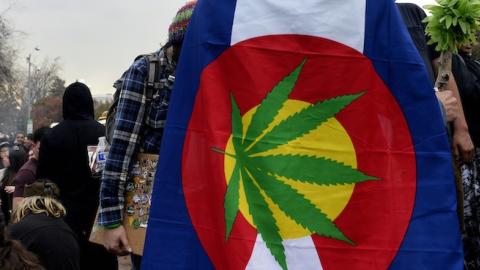A new government report on the Colorado “experiment” to legalize and commercialize marijuana sales was just released by the multi-agency intelligence fusion center of the Rocky Mountain High Intensity Drug Trafficking Area (RMHIDTA) headquarters in Denver.
Two prior reports traced the development of marijuana legalization through successive stages (medical marijuana introduction, expansion of medical marijuana dispensaries) and the new report covers full commercial legalization beginning in January, 2014. The report confirms the warnings of legalization opponents in considerable detail.
Simply put, the report shows that the impact to date has affected public health (emergency department episodes in particular), public safety (rising crime rates, traffic fatalities from drugged driving), and the integrity of public institutions, such as schools (student violations of drug policy, disruptions and expulsions).
And, predictably, adult use of marijuana has surged, as has increasing access and use by minors.
Each of these points in presented in detail in the report, along with presentation of recent research showing the cognitive and psychological damage of marijuana exposure, especially on youth, subjected to the rising potency of Colorado commercial marijuana (now exceeding 17.1 percent average potency of THC, the intoxicant in marijuana, well above the national average of 12.6 percent).
Each of the findings warrant a full discussion, but one in particular deserves immediate attention.
As the Obama Administration progressively adapted the federal response to the escalating violation of the federal Controlled Substances Act represented by Colorado’s legalization, successive memos from the U.S. Department of Justice (DOJ) provided rationales and excuses for not enforcing U.S. law.
In August of 2013, Deputy Attorney General James Cole provided guidance to all U.S. attorneys regarding marijuana criminal conduct in a memorandum, that would remain priorities for federal enforcement. Two of these priorities are:
* __Preventing the diversion of marijuana from states where it is legal under state law in some form to other states;__ and
* __Preventing state-authorized marijuana activity from being used as a cover or pretext for trafficking of other illegal drugs or other illegal activity.__
The RMHIDTA report indicates that the DOJ priorities have been ignored as trafficking spreads rapidly. Listed below are episodes where marijuana seizures followed from traffic stops. Law enforcement estimates that approximately 10 percent of marijuana being trafficked from the state is represented in these seizures.
* During 2009 – 2012, when medical marijuana was commercialized, the yearly average number interdiction seizures of Colorado marijuana increased 365 percent from 52 to 242 per year.
* During 2013 – 2014, when recreational marijuana was legalized, the yearly average interdiction seizures of Colorado marijuana increased another 34 percent from 242 to 324.
* The average pounds of Colorado marijuana seized, destined for 36 other states, increased 33 percent from 2005 – 2008 compared to 2009 – 2014, rising from 2,763 pounds to 3,671 pounds.
* In 2014, there were 360 interdiction seizures of Colorado marijuana destined for other states. When compared to the pre-commercialization average of 52 from 2005 – 2008, this represents a 592 percent increase. The most common destinations identified were Kansas, Missouri, Illinois, Oklahoma, and Florida.
In addition to traffic stops, there were parcel intercepts of marijuana.
* U.S. mail parcel interceptions of Colorado marijuana, destined for 38 other states, increased 2,033 percent from 2010 – 2014, rising from 15 to 320 intercepts.
* Pounds of Colorado marijuana seized in the U.S. mail, destined for 38 other states, increased 725 percent from 2010 – 2014, from 57 to 470 pounds.
* From 2006 – 2008, compared to 2013 – 2014, the average number of seized parcels containing Colorado marijuana that were destined outside the United States increased over 7,750 percent (from 2 to 157 parcels) and pounds of marijuana seized in those parcels increased over 1,079 percent (from 29 to 342 pounds).
The seizures and intercepts all are tied to criminal activity and, more importantly, represent a small fraction of what law enforcement believes is the actual magnitude of this growth in trafficking.
In simplest terms, marijuana legalization is poisoning Colorado and Colorado is now poisoning more and more of America.
Who will defend the families and communities now at risk?

















